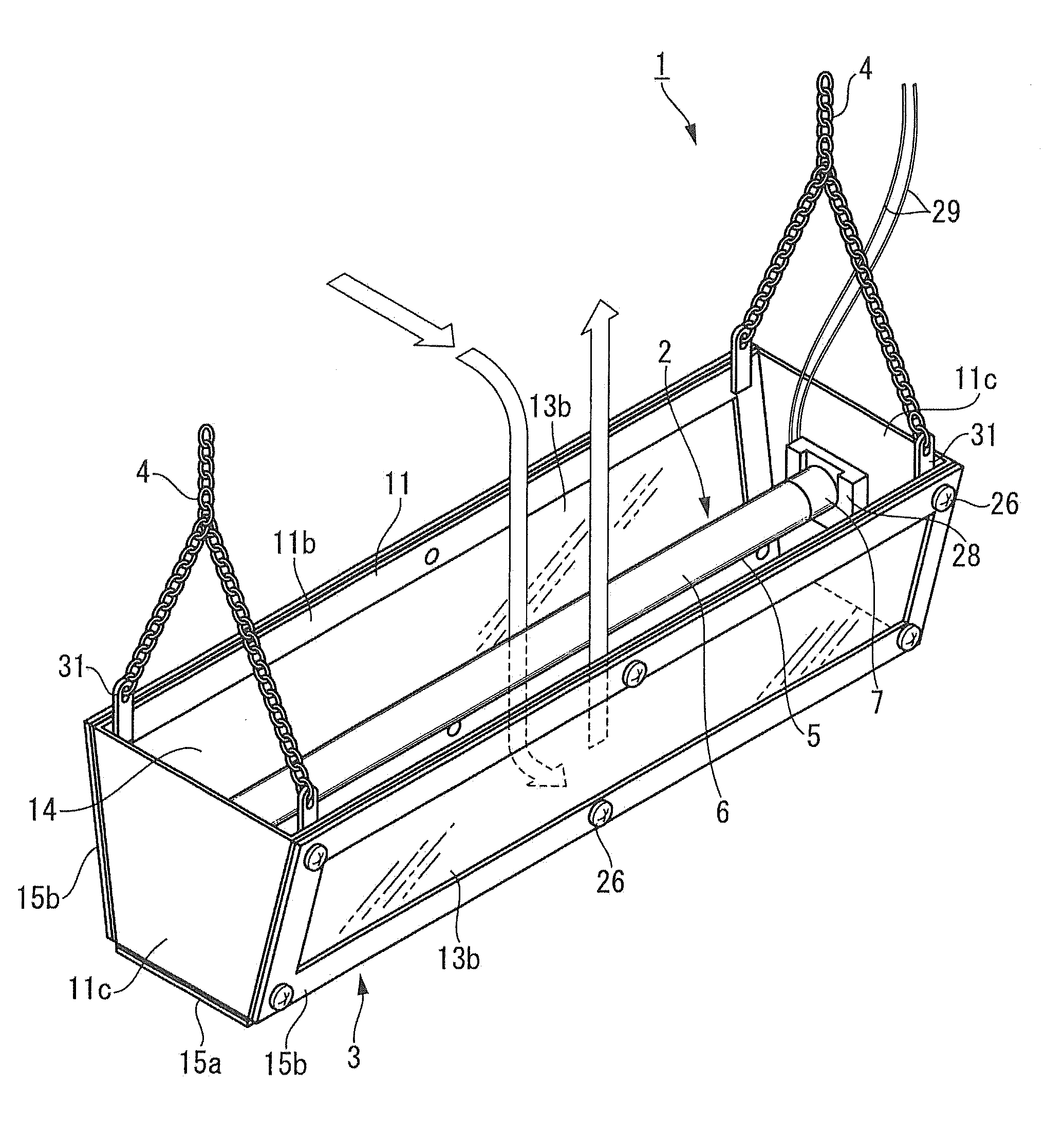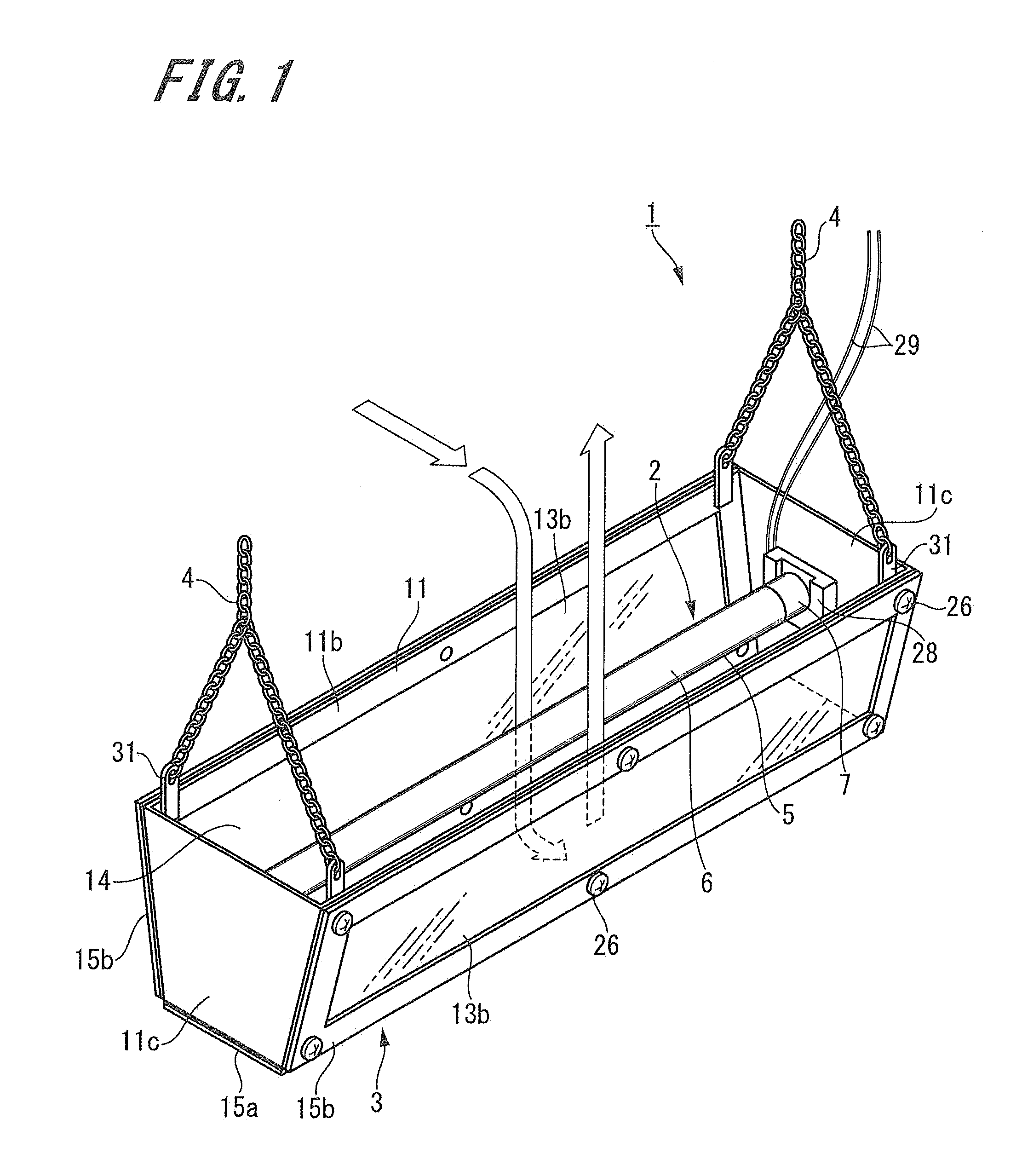Lighting and air cleaning device
a technology of air cleaning and light, which is applied in the field of light cleaning and air cleaning devices to achieve the effect of increasing visible light rays and stable illumination ligh
- Summary
- Abstract
- Description
- Claims
- Application Information
AI Technical Summary
Benefits of technology
Problems solved by technology
Method used
Image
Examples
first embodiment
[0072]Embodiments of a lighting and air cleaning device according to the present invention will be described below with reference to the accompanying drawings. FIGS. 1 to 6 show the first embodiment of the lighting and air cleaning device according to the present invention. A lighting and air cleaning device 1 described as the first embodiment includes an electromagnetic wave generation source 2 that emits electromagnetic waves including ultraviolet rays, an ultraviolet-shielding resin member 3 that houses the electromagnetic wave generation source 2, and a hanging unit 4.
[0073]The electromagnetic wave generation source 2 emits electromagnetic waves including an electromagnetic wave (ultraviolet rays) in a wavelength range of 180 (nanometers) to 379 nm and an electromagnetic wave (visible light rays) in a wavelength range of 380 to 780 nm. Examples of this electromagnetic wave generation source 2 can include an ultraviolet lamp, and an ultraviolet generation LED, a semiconductor lig...
second embodiment
[0106]FIG. 7 is a diagram showing the second embodiment of the lighting and air cleaning device according to the present invention. A lighting and air cleaning device 40 shown in this embodiment includes the ultraviolet lamp 5 that is an electromagnetic wave generation source, and a cover and casing 41 that indicates a second specific example of the ultraviolet-shielding resin member. The cover and casing 41 is formed of a horizontally long enclosure having an opening portion 42 in an upper surface. The cover and casing 41 has a horizontally long rear surface portion 41a that serves as a fixation base, a horizontally long lower surface portion 41b that continuously protrudes forward on the lower portion of the rear surface portion 41a, a front surface portion 41c that continuously rises upward on the front portion of the lower surface portion 41b, and a pair of side surface portions 41d, 41d that rises continuously on both sides in the longitudinal direction.
[0107]The entire cover a...
third embodiment
[0113]FIG. 8 is a diagram showing the third embodiment of the lighting and air cleaning device according to the present invention. A lighting and air cleaning device 50 described in this embodiment includes the ultraviolet lamp 5 that is an electromagnetic wave generation source, and a cover enclosure 51 showing a third specific example of the ultraviolet-shielding resin member. The lighting and air cleaning device 50 according to the third embodiment differs from the lighting and air cleaning device 40 according to the second embodiment in that a pair of sockets 28, 28 is fixed to predetermined positions of a building or the like, and that the cover enclosure 51 can be hung from the ultraviolet lamp 5 held between the pair of sockets 28, 28. Hence, the cover enclosure 51 will be described here, and overlapped description will not be repeated, with the same parts as in the first and second embodiments identified with like symbols.
[0114]The cover enclosure 51 is formed of a horizonta...
PUM
| Property | Measurement | Unit |
|---|---|---|
| wavelength range | aaaaa | aaaaa |
| wavelength range | aaaaa | aaaaa |
| wavelength | aaaaa | aaaaa |
Abstract
Description
Claims
Application Information
 Login to View More
Login to View More - R&D
- Intellectual Property
- Life Sciences
- Materials
- Tech Scout
- Unparalleled Data Quality
- Higher Quality Content
- 60% Fewer Hallucinations
Browse by: Latest US Patents, China's latest patents, Technical Efficacy Thesaurus, Application Domain, Technology Topic, Popular Technical Reports.
© 2025 PatSnap. All rights reserved.Legal|Privacy policy|Modern Slavery Act Transparency Statement|Sitemap|About US| Contact US: help@patsnap.com



